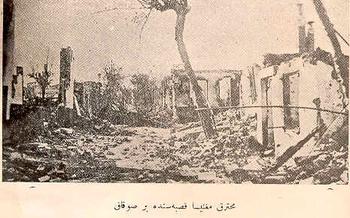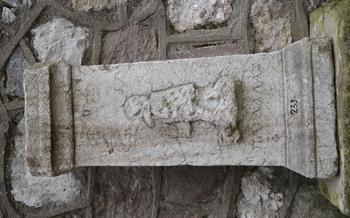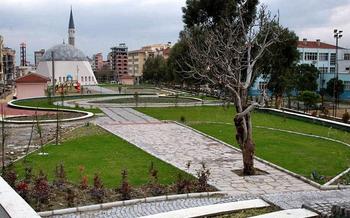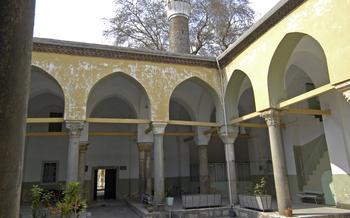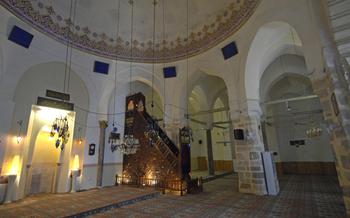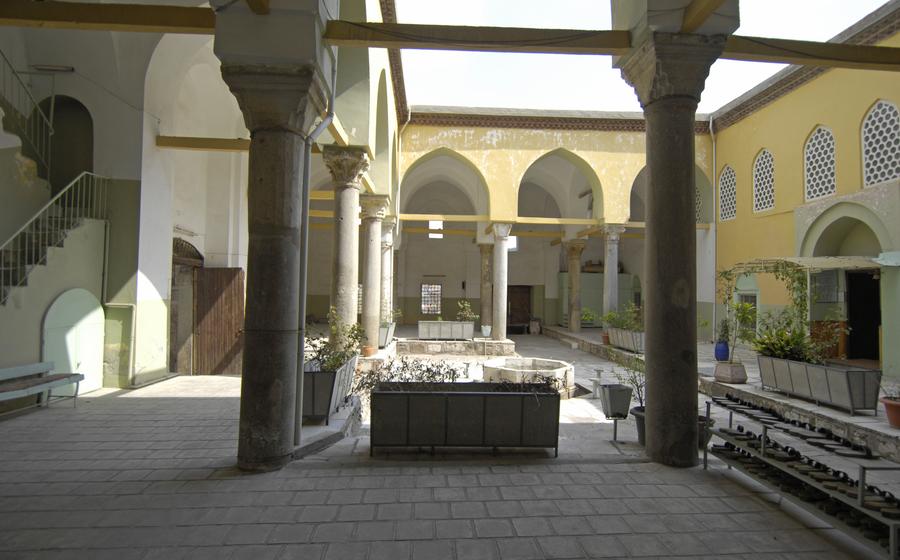
Manisa Grand Mosque
- Manisa Grand Mosque: A Majestic Architectural Marvel
- Exploring the Mosque's History and Architecture
- Unveiling the Interior Splendor
- Experiencing the Spiritual Essence
- Admiring the Exterior Elegance
- Unveiling the Mosque's Role in Education
- Witnessing Religious Ceremonies and Festivals
- Interacting with the Local Community
- Capturing the Beauty through Photography
- Exploring the Surrounding Area
- Unveiling the Legends and Folklore
- Accessibility and Practical Information
- The Mosque's Role in Tourism
- Insider Tip: Unveiling Hidden Treasures and Local Customs
Manisa Grand Mosque: A Majestic Architectural Marvel
In the heart of Manisa, a city steeped in history and culture, stands the magnificent Manisa Grand Mosque, a testament to the region's rich architectural heritage. Built in the 14th century during the reign of the Anatolian Beyliks, this grand mosque has witnessed centuries of devotion and played an integral role in shaping the spiritual and cultural landscape of the region.
With its stunning architectural features, intricate tilework, and serene ambiance, the Manisa Grand Mosque is not just a place of worship but a symbol of Manisa's architectural legacy. Its towering dome, slender minarets, and ornate mihrab captivate visitors, while the harmonious blend of Islamic and Ottoman architectural elements creates a truly awe-inspiring sight.
Beyond its architectural grandeur, the Manisa Grand Mosque holds deep spiritual significance for the Muslim community. As one of the oldest and most revered mosques in the region, it has served as a center of worship, learning, and community gatherings for centuries. The mosque's spiritual aura and the devotion of its worshippers create a palpable sense of tranquility and spirituality that envelops visitors as they step inside its sacred walls.
Exploring the Mosque's History and Architecture
The Manisa Grand Mosque stands as a testament to the rich history and architectural prowess of the region. Constructed in the 16th century, the mosque showcases a harmonious blend of Islamic and Ottoman architectural styles. Its construction was commissioned by Sultan Süleyman the Magnificent, and its design was influenced by the renowned architect Mimar Sinan. The mosque has undergone several renovations and expansions over the centuries, reflecting the evolving tastes and needs of the community.
The mosque's architecture is characterized by its imposing dome, which dominates the skyline and symbolizes the grandeur of the Ottoman Empire. The dome rests on massive pillars and is adorned with intricate patterns and designs that showcase the skill and artistry of the builders. The mosque also features four slender minarets, each reaching towards the sky and symbolizing the call to prayer. The minarets are decorated with delicate tilework and intricate carvings, adding to the overall elegance of the mosque.
The mosque's interior is equally impressive, featuring a vast prayer hall that can accommodate thousands of worshippers. The walls are adorned with exquisite tilework and calligraphy, creating a sense of awe and inspiration. The mihrab, which indicates the direction of prayer, is particularly ornate, featuring intricate carvings and colorful tiles. The minbar, or pulpit, is another focal point of the mosque, showcasing fine craftsmanship and serving as a reminder of the mosque's role as a center for religious teachings.
Unveiling the Interior Splendor
Step inside the Manisa Grand Mosque and prepare to be awestruck by its breathtaking interior. The vast prayer hall, with its soaring dimensions, creates an atmosphere of grandeur and spirituality. Gaze upon the intricate tilework and calligraphy that adorn the walls, each stroke a testament to the skill and artistry of the craftsmen who created them. The ornate mihrab, intricately carved and adorned with colorful tiles, serves as the focal point of the mosque, guiding the faithful towards Mecca. The minbar, an elevated platform used for delivering sermons, is a masterpiece of craftsmanship, featuring intricate carvings and inlaid mother-of-pearl. As natural light filters through the windows, illuminating the interior with a soft glow, you'll feel a sense of serenity and tranquility wash over you. The harmonious fusion of architectural elements creates a space that is both awe-inspiring and deeply spiritual.
Experiencing the Spiritual Essence
Within the walls of the Manisa Grand Mosque, a profound sense of tranquility and spirituality envelops visitors and worshippers alike. The daily prayers, performed with devotion and reverence, create a captivating spectacle that showcases the mosque's significance as a spiritual sanctuary. Observing these prayers offers a glimpse into the deep faith and connection that the local community shares with their religion.
The mosque's serene atmosphere invites visitors to pause and reflect, fostering a sense of inner peace and contemplation. The intricate tilework and calligraphy that adorn the walls seem to whisper stories of faith and devotion, adding to the mosque's spiritual essence. The natural light, filtering through the windows, illuminates the interior, creating a harmonious ambiance that enhances the mosque's sacred aura.
Participating in religious festivals and events held at the mosque offers a unique opportunity to immerse oneself in the vibrant traditions and customs of the local community. These celebrations, such as Ramadan prayers, Eid al-Fitr gatherings, and Mevlid Kandili commemorations, showcase the mosque's role as a center of community life. They provide visitors with a deeper understanding of the mosque's significance beyond its architectural grandeur, revealing its vital role in fostering a sense of belonging and unity among the faithful.
Admiring the Exterior Elegance
The Manisa Grand Mosque's exterior is a testament to the grandeur and elegance of Islamic architecture. The imposing dome, adorned with intricate patterns and designs, dominates the skyline, symbolizing the mosque's significance as a spiritual and architectural landmark. Slender minarets, reaching towards the sky, stand as symbols of devotion and faith, their graceful presence adding to the mosque's overall majesty.
The mosque's courtyard, with its serene ambiance, provides a tranquil space for contemplation and reflection. The surrounding gardens, with their vibrant colors and fragrant blooms, contribute to the mosque's serenity, creating a harmonious blend of natural beauty and architectural splendor. The mosque's exterior, with its captivating details and harmonious design, invites visitors to admire its architectural prowess and experience the spiritual essence that emanates from its walls.
Unveiling the Mosque's Role in Education
The Manisa Grand Mosque has historically served as a prominent center of Islamic learning, playing a pivotal role in the dissemination of knowledge and religious education. Attached to the mosque is a madrasah, an Islamic school, which has been instrumental in nurturing generations of scholars and students. The madrasah offered a comprehensive curriculum encompassing various Islamic disciplines, including Quranic studies, Hadith, Islamic law, and Arabic language.
The legacy of the mosque's madrasah is deeply intertwined with the intellectual and spiritual development of Manisa. Renowned scholars and students have graced its halls, leaving an enduring impact on Islamic scholarship and thought. The mosque's commitment to education continues to this day, as it actively promotes religious education and knowledge dissemination through various initiatives and programs.
Witnessing Religious Ceremonies and Festivals
The Manisa Grand Mosque serves as a spiritual hub for the local Muslim community, hosting a variety of religious ceremonies and festivals throughout the year. During the holy month of Ramadan, the mosque comes alive with special prayers, including the Tarawih prayers, which are performed each night during Ramadan. The atmosphere during Ramadan is particularly vibrant, with the mosque adorned with intricate decorations and the surrounding streets bustling with activity.
Eid al-Fitr, marking the end of Ramadan, is a joyous occasion celebrated with great enthusiasm at the mosque. The mosque is packed with worshippers attending the special Eid prayers, followed by communal feasting and celebrations. The mosque also hosts Mevlid Kandili, commemorating the birth of the Prophet Muhammad. This special night is marked by special prayers, recitations, and sermons, attracting a large number of devotees.
Participating in these religious ceremonies and festivals offers a unique opportunity to witness the deep devotion and spirituality of the local Muslim community. Visitors are welcome to attend these events, provided they adhere to the mosque's dress code and behave respectfully. These celebrations provide a glimpse into the rich cultural and religious traditions of Manisa and offer a deeper understanding of the role of the mosque as a center of community life.
Interacting with the Local Community
Within the walls of the Manisa Grand Mosque, a vibrant community thrives, bound by faith and tradition. Visitors are warmly welcomed into this fold, given the opportunity to engage with worshippers and immerse themselves in the mosque's rich social fabric.
Approaching worshippers with a genuine desire to learn and understand their experiences can lead to enlightening conversations and profound insights into the role of the mosque in their lives. Engaging in respectful dialogue allows visitors to gain a deeper appreciation for the spiritual significance of the mosque and its impact on the community.
Moreover, participating in community events and activities held at the mosque offers a unique glimpse into local customs and traditions. These events, often centered around religious festivals or celebrations, provide a platform for visitors to interact with the community on a deeper level.
The warmth and hospitality of the local people further enhances the experience of visiting the Manisa Grand Mosque. From sharing stories and anecdotes to offering guidance and assistance, the community members go above and beyond to ensure that visitors feel welcome and respected.
By embracing the opportunity to interact with the local community, visitors not only gain a deeper understanding of the mosque's significance but also forge meaningful connections that create lasting memories.
Capturing the Beauty through Photography
The Manisa Grand Mosque, with its architectural splendor and intricate details, presents a captivating subject for photography enthusiasts. To capture the essence of this magnificent structure, here are some photography tips:
-
Explore Different Angles and Perspectives: Experiment with various angles to showcase the mosque's grandeur. Capture the towering minarets against the clear blue sky, or focus on the intricate tilework up close.
-
Harness Natural Light: Utilize the natural light to enhance your photographs. The mosque's interior often features beautiful natural light that illuminates the ornate details.
-
Respect the Sanctity: Remember that the mosque is a place of worship, and it's essential to be respectful while taking photographs. Avoid using flash or tripods inside the prayer hall, and ask for permission before photographing worshippers.
-
Compose for Impact: Pay attention to the composition of your shots. Use leading lines, such as the arches or columns, to draw the viewer's eye towards the mosque's focal points.
Exploring the Surrounding Area
Venturing beyond the walls of the Manisa Grand Mosque, visitors will find a wealth of historical and cultural treasures waiting to be discovered.
Just a short walk away from the mosque lies the Manisa Museum, a treasure trove of artifacts and exhibits that provide a glimpse into the city's rich past. From ancient pottery and jewelry to traditional textiles and intricate carpets, the museum offers a fascinating journey through the centuries.
For those seeking a taste of local life, a stroll through the vibrant streets and markets of Manisa is a must. The city's bazaars are a kaleidoscope of colors and sounds, where vendors display an array of fresh produce, spices, and handmade goods. Be sure to sample some of the local delicacies, such as Manisa's famous meatballs or the sweet and flaky katmer pastry.
Manisa's natural beauty is also not to be missed. Surrounded by lush green mountains and sparkling rivers, the city offers a variety of outdoor activities for nature enthusiasts. Visitors can embark on scenic hikes, cycle through picturesque trails, or simply relax by the tranquil waters of the nearby lakes.
Whether you're a history buff, a culture enthusiast, or a nature lover, Manisa has something to offer every traveler. Take the time to explore the surroundings of the Manisa Grand Mosque, and you'll be rewarded with a truly unforgettable experience.
Unveiling the Legends and Folklore
The Manisa Grand Mosque holds a special place in the hearts and minds of the local community, not only for its religious significance but also for the rich tapestry of legends and folklore that surround it. These narratives, passed down through generations, offer a glimpse into the cultural heritage of Manisa and the deep connection between the mosque and its people.
Exploring Local Legends:
-
Discover the captivating tale of the mosque's foundation, believed to be guided by divine dreams and visions.
-
Unravel the mystery of the hidden treasure said to be concealed within the mosque's walls, a secret known only to a chosen few.
-
Learn about the legendary figures associated with the mosque, including pious saints, wise scholars, and benevolent spirits who are revered by the community.
Cultural Significance of Narratives:
-
Understand how these legends and stories reflect the values, beliefs, and aspirations of the local people.
-
Explore the role of the mosque as a repository of cultural memory, preserving and transmitting traditions from one generation to the next.
-
Witness the vibrant storytelling tradition that keeps these narratives alive, often shared during gatherings, festivals, and special occasions.
Interacting with Locals:
-
Engage with locals to gather firsthand accounts of these legends and folklore.
-
Listen to their personal anecdotes and experiences related to the mosque, gaining a deeper understanding of its significance in their lives.
-
Participate in local events and festivities that celebrate the mosque's heritage, immersing yourself in the vibrant cultural expressions of the community.
Preserving the Mosque's Legacy:
-
Recognize the importance of safeguarding these legends and folklore as an integral part of the mosque's identity.
-
Encourage efforts to document and preserve these narratives, ensuring their continuity for future generations.
-
Support initiatives that promote cultural heritage tourism, allowing visitors to discover and appreciate the rich tapestry of stories that surround the Manisa Grand Mosque.
Accessibility and Practical Information
The Manisa Grand Mosque is situated in the heart of Manisa, Turkey, making it easily accessible by various modes of transportation. For those arriving by car, ample parking is available in the vicinity of the mosque. Public transportation options, including buses and taxis, provide convenient connections to the mosque from different parts of the city.
Visiting hours for the mosque are generally from sunrise to sunset, allowing visitors to explore its grandeur during daylight hours. It is essential to adhere to the dress code guidelines while visiting the mosque, which includes dressing modestly and respectfully. Visitors are requested to remove their shoes before entering the prayer hall, and designated areas are available for storing footwear.
To ensure a respectful and meaningful experience, visitors are advised to maintain a quiet and reverent demeanor within the mosque. Photography is permitted, but using flash or tripods is not allowed to prevent disturbing worshippers.
Several facilities and services are available for visitors at the Manisa Grand Mosque. Guided tours are offered in various languages, providing an in-depth understanding of the mosque's history, architecture, and cultural significance. Information brochures and booklets are also available, offering self-guided exploration options.
The Mosque's Role in Tourism
The Manisa Grand Mosque stands as a testament to the city's rich heritage and architectural legacy, attracting visitors from around the world. Its stunning architecture, historical significance, and spiritual ambiance make it a must-see destination for those interested in cultural tourism.
The mosque's inclusion on various heritage trails and tourist itineraries has contributed to its growing popularity among travelers. Visitors can delve into the mosque's history and appreciate its exquisite craftsmanship, gaining insights into Islamic architecture and Ottoman design.
Moreover, the mosque's role in promoting cultural tourism extends beyond its architectural significance. It serves as a platform for interfaith dialogue and understanding, fostering tolerance and coexistence among people of different backgrounds. Through guided tours and educational programs, visitors can learn about the mosque's role in the community and its contributions to the city's cultural fabric.
By embracing responsible tourism practices, visitors can contribute to the preservation and sustainability of the mosque. Respecting the sanctity of the mosque and adhering to dress code guidelines ensures a harmonious and respectful experience for all.
In conclusion, the Manisa Grand Mosque not only serves as a place of worship but also plays a vital role in promoting cultural tourism and fostering understanding among diverse communities. Visitors are encouraged to immerse themselves in the mosque's rich history and architectural splendor, contributing to the preservation and appreciation of this iconic landmark.
Insider Tip: Unveiling Hidden Treasures and Local Customs
As you explore the Manisa Grand Mosque, keep an eye out for the intricate tilework that adorns the walls and mihrab. These tiles, often overlooked by visitors, showcase the incredible craftsmanship and artistry of the mosque's builders. Each tile is hand-painted and tells a unique story, offering a glimpse into the mosque's rich history and cultural significance.
Engage with the locals who frequent the mosque to gain insights into their customs and traditions. They may share stories about the mosque's construction, local legends, or religious practices. These conversations will provide a deeper understanding of the mosque's role in the community and the lives of its worshippers.
Venture beyond the mosque to discover hidden gems in the surrounding area. Stroll through the vibrant streets of Manisa, where you can find traditional Turkish handicrafts, local delicacies, and bustling markets. Explore the nearby Muradiye Complex, which houses a mosque, madrasah, and imaret, offering a glimpse into the city's Ottoman heritage.
Uncover the mosque's hidden architectural features, such as the intricate carvings on the minarets or the unique patterns on the dome. These details often go unnoticed but add to the mosque's overall grandeur and beauty. Engage with local artisans or craftsmen to learn about traditional Turkish crafts and techniques used in the mosque's construction. This interaction will provide a deeper appreciation for the mosque's craftsmanship and the skills of the artisans who built it.

